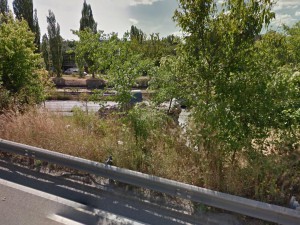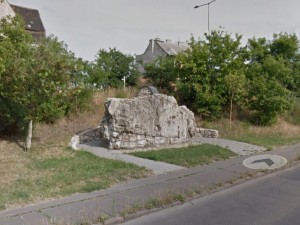The Mária rock
Next up: a good example of how later generations made use of the Roman remains.
We started our traffic jam blog with the Roman aqueduct. Let’s continue inching along in traffic towards the southernmost visible remains of this wonderful feat of engineering.
So where are we now?
We’re heading towards Árpád Bridge on Szentendrei Road, going past the Kaszásdűlő HÉV stop, where a street merges with Szentendrei Road after the Church of the Virgin of the Rock (Kövi Szűz Mária templom). If the roadside vegetation allows, we can spot the rock in question to the right. It is perhaps best if we take Dósai László Street after the HÉV stop in the direction of Mozaik Street and the Buda embankment (budai rakpart; or officially the Count János Esterházy Embankment).
But first the history!
The nearly 5 km-long aqueduct carried the water from the springs of the modern-day Roman Lido to the heart of Óbuda (in and around Flórián Square) where the legionary fortress and the Military Town once stood. What we see here is the southernmost, still visible pillar of the aqueduct. As a matter of fact, however, it’s not in its original location. Urban planners in the 1930s decided – in spite of the Monuments Commission’s position to the contrary – to move the pillar 10 metres to the east so that it wouldn’t disturb the traffic. You might be wondering: why is the Roman monument called the Mária rock? The answer is pretty simple. The 1811 flood of the Danube brought with it an icon of the Virgin Mary, which an Óbuda mason by the name of Jakab Bauer rescued and affixed to the aqueduct’s pillar. Since then many legends and stories have been told about the Mária rock. According to one tradition, here was the source of the Aranyhegy stream, in which you could see the reflection of the icon on the rock.
What can we see today?
Whether we see it from Szentendrei Road or the street leading to the Buda Embankment, we can get a glimpse of the carefully-constructed shrine. From the west we can see the pillar and the top of the structure protecting the icon; while from the east (i.e. from Szentendrei Road) we have a nice view of both.
Soon we’ll continue our search for Roman remains as there are still plenty of other hidden and conspicuous monuments to discover; but more on those later.
All in all, I encourage everyone to have a look at the aqueduct pillar/shrine on foot (for the best view), or from the warmth of your car on a cold morning – but only when the traffic isn’t moving!
Images from: Google Street View
Dániel Kővágó




